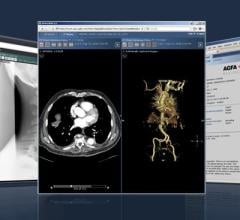
A static image drawn from a stack of brain MR images may illustrate the results of a study. But a GIF (or MP4 movie), created by the Cinebot plug-in, can scroll through that stack, providing teaching moments for residents and fellows at Georgetown University. Image courtesy of MedStar Georgetown University Hospital
Editor’s note: This article is the third in a content series by Greg Freiherr covering the Society for Imaging Informatics in Medicine (SIIM) conference in June.
A simple and easy-to-use bot automatically creates dynamic files from images acquired in any modality at MedStar Georgetown University Hospital. “Cinebot,” as it is called, improves the ability of Georgetown radiologists to teach, present and share interesting cases, according to Ross Filice, M.D., associate professor of radiology and chief of imaging informatics at MedStar Georgetown University Hospital.
“The whole thing is automated,” Filice told Imaging Technology News (ITN). “(Cinebot) will pull the study, track the images, create the movie and then send it to the user’s email.”
Dynamic images depict the real world better than static images, he asserted. “It is much easier to show someone what is happening (in angiography), if you can watch a dynamic movie rather than just one static image,” Filice said.
The circumstances are different for CT and MRI — and so is the use of Cinebot. In these modalities, radiologists may scroll through stacks of images. Dynamic files created using Cinebot show these stacks as series of images. “We make movies so that people can see the whole stack as if they were scrolling through it themselves,” he said.
SIIM Presentation
Filice and the Cinebot team plan to describe the bot during a scientific session Thursday, June 27, at the annual meeting of the Society for Imaging Informatics in Medicine (SIIM). At the presentation, the Georgetown University team will argue that dynamic images enhance radiology education better than static images by allowing a more realistic interpretation of the case.
Although dynamic files may be created from images acquired in any modality, X-ray angiography has been the most popular since the plug-in became available in June 2017. This is because “our interventional radiology group has the internal weekly teaching conference, where they present cases. They use this a lot to facilitate that conference,” Filice said.
Cinebot files are mostly used internally to teach cases to residents and fellows. They are also shown at external conferences to illustrate presentations. The files could be sent to referring physicians to illustrate findings, although Filice is not aware of instances when they were used for this purpose. Medico-legal — not technology — concerns have been the big limitation, according to Filice. A major worry, he said, is the protection of patient health information (PHI).
Cinebot tries to exclude patient-specific data. Occasionally, however, such data get into the files. It is the responsibility of the requestor, Filice said, to ensure that PHI is not accidentally transmitted.
The bot overcomes what he describes as “technology obstacles” associated with converting DICOM data. Cinebot deals with the DICOM challenge by going to the PACS archive and using DICOM toolkits to pull up and assemble the appropriate images.
Dynamic files are emailed internally to requestors, who are responsible for ensuring that all protected health information has been excluded.
“We audit who is viewing the study, who is requesting the movie, and where the movies (and GIFs) are sent,” he said.
How Cinebot Works
Users at Georgetown University Hospital — typically radiologists or attending physicians — trigger Cinebot using a JavaScript plug-in, which appears on-screen in a display window of the Georgetown University PACS. Users right-click the images to be included in the movie or GIF. The bot then pulls the images from the archived study and compiles them in either file format.
GIFs are especially popular because, when clicked, they play in loops. Also they reliably play in PowerPoint presentations, Filice noted.
Cinebot was written specifically for use on the Georgetown University Hospital PACS. Therefore, it is not plug-and-play on any PACS. To be used at other institutions, Cinebot would have to be customized to work with their PACS, he said. Also, the Georgetown University technology commercialization office would have to approve its external use.
Filice said he would “be happy to try to work out” a mechanism to share Cinebot with interested parties.
Greg Freiherr is a contributing editor to Imaging Technology News (ITN). Over the past three decades, he has served as business and technology editor for publications in medical imaging, as well as consulted for vendors, professional organizations, academia, and financial institutions.
Related content:
DeepAAA Uses AI to Look Automatically For Aneurysms


 May 17, 2024
May 17, 2024 








